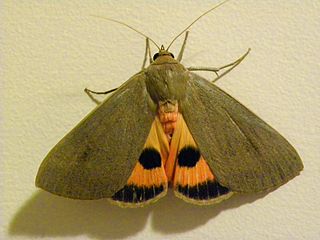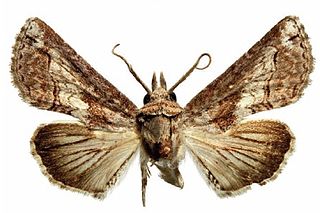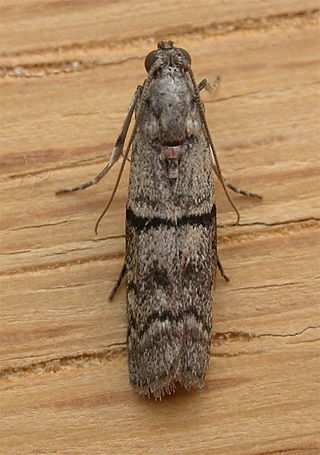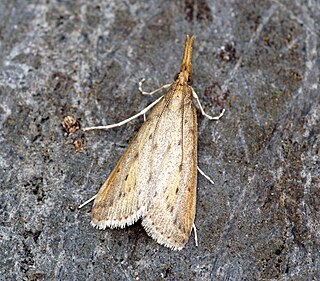
Spilomelinae is a very species-rich subfamily of the lepidopteran family Crambidae, the crambid snout moths. With 4,135 described species in 344 genera worldwide, it is the most speciose group among pyraloids.

The Thyrididae comprise the family of picture-winged leaf moths. They are the only family in the superfamily Thyridoidea, which sometimes has been included in the Pyraloidea, but this isn't supported by cladistic analysis.

The Pyralinae are the typical subfamily of snout moths and occur essentially worldwide, in some cases aided by involuntary introduction by humans. They are rather rare in the Americas however, and their diversity in the Australian region is also limited. Altogether, this subfamily includes about 900 described species, but new ones continue to be discovered. Like many of their relatives in the superfamily Pyraloidea, the caterpillar larvae of many Pyralinae – and in some cases even the adults – have evolved the ability to use unusual foods for nutrition; a few of these can become harmful to humans as pests of stored goods.

The Pyralini are a tribe of snout moths described by Pierre André Latreille in 1809. They belong to the subfamily Pyralinae, which contains the "typical" snout moths of the Old World and some other regions. The genus list presented here is provisional.

Omiodes is a moth genus in the family Crambidae. Several species are endemic to Hawaii.

Orthonama obstipata, the gem, is a moth of the family Geometridae. The species was first described by Johan Christian Fabricius in 1794. It is a cosmopolitan species. In continental Europe though in the northeast, its range does not significantly extend beyond the Baltic region and it is absent from northern Russia. This well-flying species is prone to vagrancy and able to cross considerable distances of the open sea; it can thus be regularly found on the British Isles and even on Iceland.
Trischalis is a genus of moths in the family Erebidae erected by George Hampson in 1894.

Derambila is a genus of moths in the family Geometridae first described by Francis Walker in 1863.

Euteliidae is a family of moths in the superfamily Noctuoidea. The family was erected by Augustus Radcliffe Grote in 1882.

The Phycitini are a tribe of moths of the family Pyralidae.
Trischalis purpurastriata is a moth in the family Erebidae. It was described by Rob de Vos and Henricus Jacobus Gerardus van Mastrigt in 2007. It is found in Papua, Indonesia.
Trischalis splendens is a moth in the family Erebidae. It was described by Rob de Vos and Henricus Jacobus Gerardus van Mastrigt in 2007. It is found in Papua, Indonesia.
Trischalis zahrae is a moth in the family Erebidae. It was described by Rob de Vos and Henricus Jacobus Gerardus van Mastrigt in 2007. It is found in New Guinea.
Trischalis iridescens is a moth in the family Erebidae. It was described by Walter Rothschild in 1913. It is found in New Guinea.
Trischalis convoluta is a moth in the family Erebidae. It was described by George Hampson in 1918. It is found in the Philippines.
Trischalis aureoplagiata is a moth in the family Erebidae. It was described by Walter Rothschild in 1913. It is found in New Guinea.
Trischalis absconditana is a moth in the family Erebidae. It was described by Francis Walker in 1863. It is found in Assam in India and in Sri Lanka.
Trischalis stomata is a moth in the family Erebidae. It was described by Jeremy Daniel Holloway in 2001. It is found on Borneo, Bali and in Singapore.

Schoenobiinae is a subfamily of the lepidopteran family Crambidae. The subfamily was described by Philogène Auguste Joseph Duponchel in 1846.

Margaroniini is a tribe of the species-rich subfamily Spilomelinae in the pyraloid moth family Crambidae. The tribe was erected by Charles Swinhoe and Everard Charles Cotes in 1889, originally as family Margaronidae.










